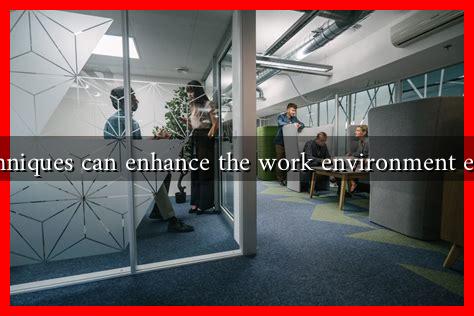-
Table of Contents
What Techniques Can Enhance the Work Environment Experience?
Creating a positive work environment is essential for fostering employee satisfaction, productivity, and overall organizational success. A well-structured work environment not only boosts morale but also enhances collaboration and innovation. In this article, we will explore various techniques that can significantly improve the work experience for employees, supported by research, case studies, and practical examples.
The Importance of a Positive Work Environment
A positive work environment is characterized by supportive relationships, open communication, and a culture of respect. According to a study by Gallup, organizations with engaged employees outperform their competitors by 147% in earnings per share. This statistic underscores the importance of investing in the work environment to enhance employee experience.
Techniques to Enhance the Work Environment
Here are several effective techniques that organizations can implement to create a more enriching work environment:
- Flexible Work Arrangements
- Open Communication Channels
- Employee Recognition Programs
- Creating a Comfortable Physical Space
- Promoting Work-Life Balance
- Team-Building Activities
Offering flexible work hours and remote work options can significantly improve employee satisfaction. A survey by Buffer found that 98% of employees would like to work remotely at least some of the time for the rest of their careers. Flexibility allows employees to balance their personal and professional lives more effectively.
Encouraging open communication fosters trust and transparency within the organization. Regular feedback sessions, town hall meetings, and anonymous suggestion boxes can help employees voice their opinions and feel valued. A study by Salesforce revealed that 86% of employees and executives cite lack of collaboration or ineffective communication for workplace failures.
Recognizing and rewarding employees for their hard work can boost morale and motivation. Implementing programs such as ‘Employee of the Month’ or peer-to-peer recognition platforms can create a culture of appreciation. According to a study by O.C. Tanner, 79% of employees who quit their jobs cite a lack of appreciation as a key reason for leaving.
The physical workspace plays a crucial role in employee satisfaction. Ergonomic furniture, adequate lighting, and designated relaxation areas can enhance comfort and productivity. A study by the World Green Building Council found that well-designed workspaces can increase productivity by up to 11%.
Encouraging employees to maintain a healthy work-life balance is vital for their well-being. Organizations can promote this by offering wellness programs, mental health days, and encouraging employees to take their vacation time. A report by the American Psychological Association found that employees who feel supported in their work-life balance are more engaged and productive.
Organizing team-building activities can strengthen relationships among employees and improve collaboration. Activities such as workshops, retreats, or even casual social gatherings can help break down barriers and foster a sense of community. According to a study by the University of Central Florida, team-building activities can improve team performance by 20-25%.
Case Studies: Successful Implementation
Several organizations have successfully implemented these techniques to enhance their work environment:
- Google: Known for its innovative work culture, Google offers flexible work hours, on-site wellness programs, and a variety of recreational facilities. This approach has led to high employee satisfaction and retention rates.
- Salesforce: Salesforce emphasizes open communication and employee recognition. Their ‘Ohana Culture’ promotes family-like support among employees, resulting in a highly engaged workforce.
- Buffer: Buffer has embraced remote work and transparency, allowing employees to work from anywhere while maintaining open communication through regular check-ins and feedback sessions.
Conclusion
Enhancing the work environment experience is a multifaceted endeavor that requires a commitment to employee well-being, open communication, and recognition. By implementing techniques such as flexible work arrangements, promoting work-life balance, and creating a comfortable physical space, organizations can foster a positive atmosphere that boosts productivity and employee satisfaction. As demonstrated by successful companies like Google and Salesforce, investing in the work environment is not just beneficial for employees; it also drives organizational success. For more insights on improving workplace culture, consider exploring resources from the Gallup Organization.

